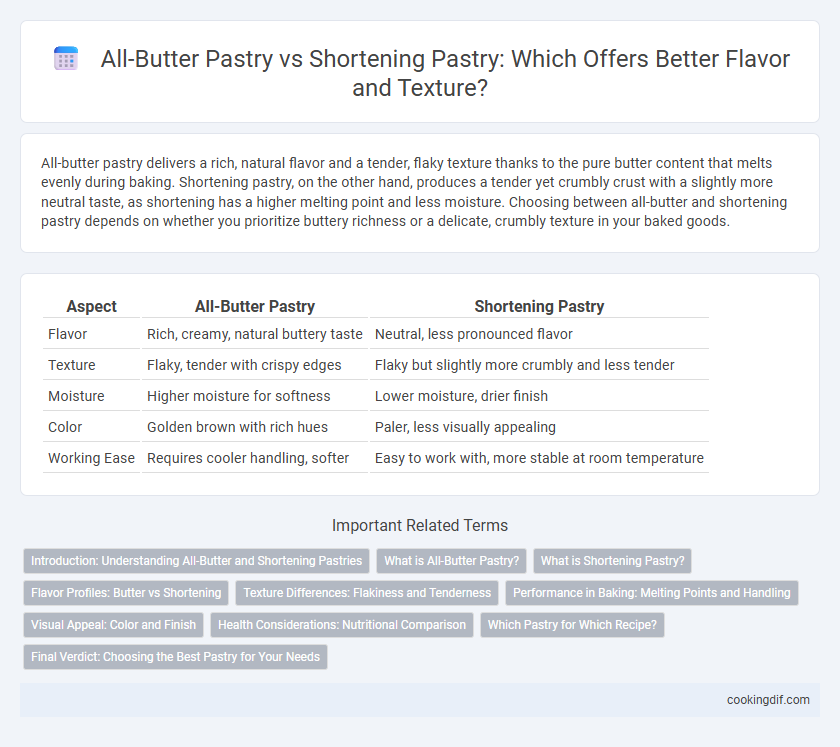All-butter pastry delivers a rich, natural flavor and a tender, flaky texture thanks to the pure butter content that melts evenly during baking. Shortening pastry, on the other hand, produces a tender yet crumbly crust with a slightly more neutral taste, as shortening has a higher melting point and less moisture. Choosing between all-butter and shortening pastry depends on whether you prioritize buttery richness or a delicate, crumbly texture in your baked goods.
Table of Comparison
| Aspect | All-Butter Pastry | Shortening Pastry |
|---|---|---|
| Flavor | Rich, creamy, natural buttery taste | Neutral, less pronounced flavor |
| Texture | Flaky, tender with crispy edges | Flaky but slightly more crumbly and less tender |
| Moisture | Higher moisture for softness | Lower moisture, drier finish |
| Color | Golden brown with rich hues | Paler, less visually appealing |
| Working Ease | Requires cooler handling, softer | Easy to work with, more stable at room temperature |
Introduction: Understanding All-Butter and Shortening Pastries
All-butter pastry delivers a rich, creamy flavor and tender, flaky texture due to the high milk fat content of butter, which also enhances browning during baking. Shortening pastry offers a lighter, more neutral taste with a slightly crumbly texture, as vegetable shortening has a higher melting point that creates distinct, even layers. Choosing between the two depends on whether the priority is buttery richness or a subtler, crispier consistency.
What is All-Butter Pastry?
All-butter pastry is made exclusively with butter, which imparts a rich, creamy flavor and a tender, flaky texture due to butter's lower melting point and water content. The natural fats in butter create distinct layers as they melt during baking, resulting in a light, delicate crumb that is highly prized in classic pastries. This contrasts with shortening pastry, where neutral-flavored vegetable fats produce a more uniform, crumbly texture but lack the depth of flavor found in all-butter versions.
What is Shortening Pastry?
Shortening pastry is made using solid fat like vegetable shortening instead of butter, resulting in a tender, flaky texture with less rich flavor. Unlike all-butter pastry, shortening pastry remains more stable at higher temperatures and offers a crispier bite due to its higher melting point. This type of pastry is favored in commercial baking for its consistent texture and longer shelf life.
Flavor Profiles: Butter vs Shortening
All-butter pastry delivers a rich, creamy flavor with a natural sweetness and a tender yet flaky texture due to the moisture content in butter. Shortening pastry, on the other hand, offers a more neutral taste and creates a crisper, more stable texture because shortening has a higher melting point and lacks water. The choice between butter and shortening directly influences the pastry's flavor complexity and mouthfeel, with butter enhancing flavor depth and shortening providing superior flakiness.
Texture Differences: Flakiness and Tenderness
All-butter pastry delivers superior flakiness and a rich, tender crumb due to the butter's higher water content, which creates steam pockets during baking. Shortening pastry produces a more tender, crumbly texture but lacks the distinct layered flakiness that butter imparts. Butter's melting point also enhances the pastry's delicate structure, making it a preferred choice for flaky, flavorful pastries.
Performance in Baking: Melting Points and Handling
All-butter pastry offers a rich flavor and a tender, flaky texture due to its lower melting point of around 90-95degF, which causes the butter to melt quickly during baking, creating steam pockets that enhance flakiness. Shortening pastry, with a higher melting point of approximately 110-120degF, provides greater ease of handling and results in a more stable, crumbly texture but lacks the depth of flavor found in butter. Performance in baking is influenced by these melting points, where all-butter pastry demands careful handling to prevent over-softening, while shortening pastry is more forgiving in warmer environments.
Visual Appeal: Color and Finish
All-butter pastry delivers a golden, glossy finish with a rich, buttery aroma that enhances visual appeal, while shortening pastry tends to be paler with a more matte surface due to the absence of butter's natural browning compounds. The inclusion of butter in pastry dough promotes Maillard reaction and caramelization during baking, resulting in a visually inviting crust with a slightly crisp texture. In contrast, shortening-based pastry often exhibits a softer, less vibrant crust that lacks the appealing sheen characteristic of all-butter varieties.
Health Considerations: Nutritional Comparison
All-butter pastry contains higher levels of saturated fat and cholesterol compared to shortening pastry, which often includes hydrogenated fats that may contain trans fats linked to heart disease. Butter provides essential vitamins like A and E, whereas many shortenings lack these nutrients due to processing. Choosing whole butter supports more natural ingredients but may impact cardiovascular health, while some shortenings offer lower saturated fat but pose risks from industrial trans fats.
Which Pastry for Which Recipe?
All-butter pastry delivers a rich, flaky texture with a pronounced buttery flavor ideal for tarts and pies where flavor is paramount. Shortening pastry offers a tender, crumbly texture with a neutral taste, making it suitable for recipes requiring a sturdy crust like quiches or savory pies. For delicate desserts, choose all-butter for depth of flavor, while shortening enhances texture in hearty, savory dishes.
Final Verdict: Choosing the Best Pastry for Your Needs
All-butter pastry delivers rich, buttery flavor and a tender, flaky texture prized in gourmet baking, while shortening pastry offers a more neutral taste with a consistently crisp and crumbly finish. The ideal choice depends on the desired balance between authentic buttery richness and stability in texture, especially under various baking conditions. For flavor-focused recipes, all-butter pastry excels, whereas shortening pastry suits applications requiring durability and ease of handling.
All-butter pastry vs shortening pastry for flavor and texture Infographic

 cookingdif.com
cookingdif.com